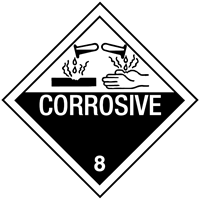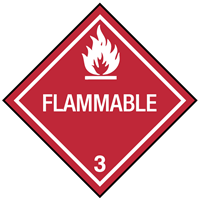
 Print
Print
Chemical Datasheet
MORPHOLINE |


|
Chemical Identifiers
| CAS Number |
UN/NA Number |
DOT Hazard Label |
USCG CHRIS Code |
- 110-91-8

|
|
- Corrosive
- Flammable Liquid
|
|
| NIOSH Pocket Guide |
International Chem Safety Card |
|
Morpholine
|
|
NFPA 704
General Description
A colorless liquid with a fishlike odor. Flash point 100°F. Corrosive to tissue. Less dense than water and soluble in water. Vapors heavier than air. Used to make other chemicals, as a corrosion inhibitor, and in detergents.
Hazards
Reactivity Alerts
Air & Water Reactions
Highly flammable. Water soluble. Sensitive to moisture.
Fire Hazard
FLAMMABLE. Flashback along vapor trail may occur. Vapor may explode if ignited in an enclosed area. Irritating vapors are generated when heated. Vapor is heavier than air and may travel some distance to source of ignition and flash back. (USCG, 1999)
Health Hazard
VAPOR: Irritating to eyes, nose and throat. If inhaled, will cause nausea, headache, or difficult breathing. LIQUID: Irritating to skin and eyes. (USCG, 1999)
Reactivity Profile
MORPHOLINE neutralizes acids in exothermic reactions to form salts plus water. May be incompatible with isocyanates, halogenated organics, peroxides, phenols (acidic), epoxides, anhydrides, and acid halides. May generate hydrogen, a flammable gas, in combination with strong reducing agents such as hydrides. Sensitive to moisture. Reacts readily with oxidizing agents (NTP, 1992).
Belongs to the Following Reactive Group(s)
- Amines, Phosphines, and Pyridines
Potentially Incompatible Absorbents
Use caution: Liquids with this reactive group classification have been
known to react with the
absorbent
listed below.
- Mineral-Based & Clay-Based Absorbents
Response Recommendations
Isolation and Evacuation
Excerpt from ERG Guide 132 [Flammable Liquids - Corrosive]:
IMMEDIATE PRECAUTIONARY MEASURE: Isolate spill or leak area for at least 50 meters (150 feet) in all directions.
SPILL: Increase the immediate precautionary measure distance, in the downwind direction, as necessary.
FIRE: If tank, rail tank car or highway tank is involved in a fire, ISOLATE for 800 meters (1/2 mile) in all directions; also, consider initial evacuation for 800 meters (1/2 mile) in all directions. (ERG, 2024)
Firefighting
Excerpt from ERG Guide 132 [Flammable Liquids - Corrosive]:
Some of these materials may react violently with water.
SMALL FIRE: Dry chemical, CO2, water spray or alcohol-resistant foam.
LARGE FIRE: Water spray, fog or alcohol-resistant foam. If it can be done safely, move undamaged containers away from the area around the fire. Dike runoff from fire control for later disposal. Do not get water inside containers.
FIRE INVOLVING TANKS, RAIL TANK CARS OR HIGHWAY TANKS: Fight fire from maximum distance or use unmanned master stream devices or monitor nozzles. Cool containers with flooding quantities of water until well after fire is out. Withdraw immediately in case of rising sound from venting safety devices or discoloration of tank. ALWAYS stay away from tanks in direct contact with flames. For massive fire, use unmanned master stream devices or monitor nozzles; if this is impossible, withdraw from area and let fire burn. (ERG, 2024)
Non-Fire Response
Excerpt from ERG Guide 132 [Flammable Liquids - Corrosive]:
ELIMINATE all ignition sources (no smoking, flares, sparks or flames) from immediate area. All equipment used when handling the product must be grounded. Do not touch or walk through spilled material. Stop leak if you can do it without risk. Prevent entry into waterways, sewers, basements or confined areas. A vapor-suppressing foam may be used to reduce vapors. Absorb with earth, sand or other non-combustible material. For hydrazine, absorb with DRY sand or inert absorbent (vermiculite or absorbent pads). Use clean, non-sparking tools to collect absorbed material.
LARGE SPILL: Dike far ahead of liquid spill for later disposal. Water spray may reduce vapor, but may not prevent ignition in closed spaces. (ERG, 2024)
Protective Clothing
Excerpt from NIOSH Pocket Guide for Morpholine:
Skin: PREVENT SKIN CONTACT - Wear appropriate personal protective clothing to prevent skin contact.
Eyes: PREVENT EYE CONTACT - Wear appropriate eye protection to prevent eye contact.
Wash skin: WHEN CONTAMINATED - The worker should immediately wash the skin when it becomes contaminated.
Remove: WHEN WET (FLAMMABLE) - Work clothing that becomes wet should be immediately removed due to its flammability hazard (i.e., for liquids with a flash point <100°F).
Change: No recommendation is made specifying the need for the worker to change clothing after the workshift.
Provide:
• EYEWASH (>15%) - Eyewash fountains should be provided in areas where there is any possibility that workers could be exposed to the substances; this is irrespective of the recommendation involving the wearing of eye protection. (>15%)
• QUICK DRENCH (>25%) - Facilities for quickly drenching the body should be provided within the immediate work area for emergency use where there is a possibility of exposure. [Note: It is intended that these facilities provide a sufficient quantity or flow of water to quickly remove the substance from any body areas likely to be exposed. The actual determination of what constitutes an adequate quick drench facility depends on the specific circumstances. In certain instances, a deluge shower should be readily available, whereas in others, the availability of water from a sink or hose could be considered adequate.] (>25%) (NIOSH, 2024)
DuPont Tychem® Suit Fabrics
Normalized Breakthrough Times (in Minutes)
| Chemical |
CAS Number |
State |
QS |
QC |
SL |
C3 |
TF |
TP |
RC |
TK |
RF |
| Diethylene imide oxide |
110-91-8 |
Liquid |
|
|
158 |
|
|
|
>480 |
>480 |
>480 |
| Morpholine |
110-91-8 |
Liquid |
|
|
158 |
|
|
|
>480 |
>480 |
>480 |
Special Warning from DuPont: Tychem® and Tyvek® fabrics should not be
used around heat, flames, sparks or in potentially flammable or
explosive environments. Only...
(DuPont, 2024)
First Aid
EYES: First check the victim for contact lenses and remove if present. Flush victim's eyes with water or normal saline solution for 20 to 30 minutes while simultaneously calling a hospital or poison control center. Do not put any ointments, oils, or medication in the victim's eyes without specific instructions from a physician. IMMEDIATELY transport the victim after flushing eyes to a hospital even if no symptoms (such as redness or irritation) develop.
SKIN: IMMEDIATELY flood affected skin with water while removing and isolating all contaminated clothing. Gently wash all affected skin areas thoroughly with soap and water. IMMEDIATELY call a hospital or poison control center even if no symptoms (such as redness or irritation) develop. IMMEDIATELY transport the victim to a hospital for treatment after washing the affected areas.
INHALATION: IMMEDIATELY leave the contaminated area; take deep breaths of fresh air. If symptoms (such as wheezing, coughing, shortness of breath, or burning in the mouth, throat, or chest) develop, call a physician and be prepared to transport the victim to a hospital. Provide proper respiratory protection to rescuers entering an unknown atmosphere. Whenever possible, Self-Contained Breathing Apparatus (SCBA) should be used; if not available, use a level of protection greater than or equal to that advised under Protective Clothing.
INGESTION: DO NOT INDUCE VOMITING. Corrosive chemicals will destroy the membranes of the mouth, throat, and esophagus and, in addition, have a high risk of being aspirated into the victim's lungs during vomiting which increases the medical problems. If the victim is conscious and not convulsing, give 1 or 2 glasses of water to dilute the chemical and IMMEDIATELY call a hospital or poison control center. IMMEDIATELY transport the victim to a hospital. If the victim is convulsing or unconscious, do not give anything by mouth, ensure that the victim's airway is open and lay the victim on his/her side with the head lower than the body. DO NOT INDUCE VOMITING. Transport the victim IMMEDIATELY to a hospital. (NTP, 1992)
Physical Properties
Flash Point:
100°F
(NTP, 1992)
Lower Explosive Limit (LEL):
1.8 %
(USCG, 1999)
Upper Explosive Limit (UEL):
10.8 %
(USCG, 1999)
Autoignition Temperature:
590°F
(USCG, 1999)
Melting Point:
23.2°F
(NTP, 1992)
Vapor Pressure:
6.6 mmHg
at 68°F
(NTP, 1992)
Vapor Density (Relative to Air):
3
(NTP, 1992)
- Heavier than air; will sink
Specific Gravity:
1
at 68°F
(USCG, 1999)
Boiling Point:
264°F
at 760 mmHg
(NTP, 1992)
Molecular Weight:
87.12
(NTP, 1992)
Water Solubility:
Soluble
(NTP, 1992)
Ionization Energy/Potential:
8.88 eV
(NIOSH, 2024)
IDLH:
1400 ppm
; Based on 10% of the lower explosive limit.
(NIOSH, 2024)
AEGLs (Acute Exposure Guideline Levels)
No AEGL information available.
ERPGs (Emergency Response Planning Guidelines)
No ERPG information available.
PACs (Protective Action Criteria)
| Chemical |
PAC-1 |
PAC-2 |
PAC-3 |
|
| Morpholine (110-91-8)
|
30 ppm |
1300 ppm |
8000 ppm  |
LEL = 14000 ppm |
(DOE, 2024)
Regulatory Information
EPA Consolidated List of Lists
No regulatory information available.
CISA Chemical Facility Anti-Terrorism Standards (CFATS)
No regulatory information available.
OSHA Process Safety Management (PSM) Standard List
No regulatory information available.
Alternate Chemical Names
- BASF 238
- DIETHYLENE IMIDOXIDE
- DIETHYLENE OXIMIDE
- DIETHYLENEIMIDE OXIDE
- DIETHYLENIMIDE OXIDE
- DIEYTHYLENE OXIMIDE
- DREWAMINE
- 2H-1,4-OXAZINE, TETRAHYDRO-
- 4H-1,4-OXAZINE, TETRAHYDRO-
- MORPHOLINE
- 1-OXA-4-AZACYCLOHEXANE
- P-ISOXAZINE, TETRAHYDRO-
- TETRAHYDRO-1,4-OXAZINE
- TETRAHYDRO-2H-1, 4-OXAZINE
- TETRAHYDRO-2H-1,4-OXAZINE
- TETRAHYDRO-P-OXAZINE



 Print
Print

